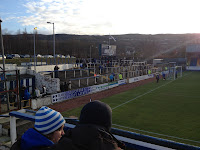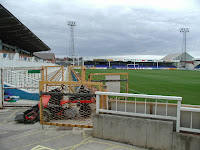Greenock Morton are a professional football club from the old shipbuilding town of Greenock, which is located on the south bank of the River Clyde, approximately twenty three miles from Glasgow. The club were formed as Morton FC in 1874. It is thought Morton comes from a local street called Morton Terrace, which was a road where several players lived.

'The Ton' became founder members of the Scottish League Division Two in 1894, moving into their Cappielow Park ground four years later being promoted to the First Division soon after. The club would have spells in the two divisions until league restructuring in the 80's.
In 1922 Morton lifted the Scottish Cup after defeating Rangers 1-0 with a Jimmy Gourlay goal. During World War Two Stanley Matthews and Tommy Lawton guested for the club while on service duties. Morton reached the final once more in 1948, again to face Rangers. The game went to replay after a 1-1 draw, with the Ibrox outfit scoring the only goal iun extra time. The two matches attracted astonishing crowds of 132,629 and then 133,750 to Hampden Park.

In October 1963 The Ton once again faced Rangers in a major final; this time the League Cup. They fell short once more, losing 5-0 in front of a Hampden audience of 106,000. European football came to Cappielow in the 1967-68 season with Morton competing in the Inter City Fairs Cup, where they were defeated by Chelsea.
From 1976 to 1983 Andy Ritchie was the darling of the Morton fans as he scored 100 goals for the club, with the club changing its name to Greenock Morton in 1994 to acknowledge their home town. After a six year spell in Division One the team were relegated at the end of the 2000-01 season as the club entered administration with the finances in a perilous state. A second successive relegation followed as the club found themselves in Scottish football's fourth tier.

Fortunately the club were taken over by confectioner businessman Douglas Rae as the team won the Division Three title at the first attempt under the managership of John McCormack. The deciding league game drew a gate of 8,479 to Cappielow. Jim McInally came in as manager as the team failed to secure another elevation, and he led the side up at the end the 2006-07 season after three seasons of narrow failure.
Morton's promotion to the First Division saw a few seasons of struggle, with managers McInally, Davie Irons and James Grady all taking turns to try and lift The Tons to the Premier League without success. Former winger with several clubs Allan Moore arrived from Stirling Albion with a good track record in May 2010.

Moore came close to taking Morton back to the Premier League in 2012-13, but they lost in the title race to Partick Thistle, eventually finishing as runners up.
Greenock Morton FC will play in the Scottish League Division One in the 2013-14 season.
My visit
Greenock Morton 2 Livingston 1 (Saturday 19th January 2013) Scottish League Division One (att: 1,913)
It was that time of the year where I had a weekend off work and decided that a lads away was in order. After visiting Dusseldorf the previous year, my good pal Karl Theobald expressed an interest in visiting Glasgow. That was fine for me, as I'd enjoyed several great nights out there in the past.

We'd gone on a tour of Ibrox on the Friday evening before enjoying a very good night out. Our original plan was to head to the Premier League encounter between Hibernian and Dundee, but the weather that had hit large parts of the UK had threatened to arrive in Edinburgh. The last thing we wanted was a wasted afternoon, so over a coffee I suggested either Morton or Partick Thistle against Falkirk. After checking the league table that revealed that The Ton were top and Livi third, plus the attraction of being able to stand up we agreed to have a ride along the banks of the Clyde.
Our ticket seller at Central Station told us we needed to be 'kegged up' if we were heading to the match. This didn't augur well, but he was laughing so I presumed he was joking? After a beer in the Crystal Palace, which was filling with Celtic fans, we jumped aboard the Gourock train alighting at Cartsdyke. After a short walk we found ourselves in a bar, which I think may have been called The Norseman? The place had seen better days, but haven't we all and the welcome was warm.
We enjoyed a couple of Tenants while chatting to fans of both sides. There was certainly plenty of away support enjoying the warmth. At around 2.45 we entered Cappielow for £15 and immediately fell for the place.


The Main Stand was long and low with a raised seating deck and magnificent floodlights raised on the roof and the railway line behind it. The Livi fans sat at the far end, with just about all the inhabitants of the pub in there. The far Wee Dublin End was closed but it was an open end with bench seats bolted onto it. Apparently a roof had been bought from St Mirren's old Love Street ground and was going to go up over the seats. The Sinclair Street End had an open terracing with thick round crush barriers, but the crowning glory was The Cowshed. It covered most of the final side with a good bank of terracing underneath. A few rows of seats were at the front, with the steps having magnificent wide barriers that were perfect for balancing warm drinks.
The catering had to be tried, as the super efficient snack bar was found in the concourse behind the shed. The scotch pie and chicken broth proved outstanding value for £2.50. We had rapidly grown a soft spot for The Ton. I wasn't a big fan of Livingston anyway, as they were one of the first 'franchise' clubs when they moved Meadowbank Thistle lock stock and barrel to their new town.

It was good to see the teams emerge with the officials and get straight on with proceedings without any handshaking nonsence. Later on any substitutions were sorted by the linesman on the far side. There was no fourth official, prompting the question of what's the point of them? Incidentally we had lineswomen Lorraine Clark on the near side who seemed to do a decent job, or the players and fans cut her a bit of extra slack? A few weeks earlier she had run the line at Rangers against Berwick Rangers in front of nearly 45,000 fans.
The locals roared their team on, with some of the distinguishable comments making us laugh out loud. They certainly didn't take kindly to the antics of a visiting player who fell over, despite being nearly snapped in half by one of their heroes. The rich accents only added to the effect.
A fine move from a corner led to Martin Hardie firing Morton ahead. They played some nice stuff, but losat their way somewhat as the talented visitors got a hold of the game. We commented at half time that Morton needed a second goal as Livi looked dangerous. However, when the equaliser did come it was from a goalkeeping error Greavsie used to thrive on when hosting his Saturday lunchtime programme with Ian St John. A weak shot from Iain Russell sneeked past Derek Gaston. As Karl said at the time, "I'd have saved that."

Rather than knocking the stuffing out of the home side as it could have easily done, they pulled themselves together and scored what would prove to be the winner with twenty two minutes remaining when Peter MacDonald headed home at the far stick.
We went and stood on the open end with around ten minutes to go, before making a bolt for it five minutes from the end. We wanted to catch the 4.51 train back to go for a meal and to prepare for our Saturday night out as otherwise we'd have been waiting for a further thirty minutes in what was in all fairness not a great place.
A home fan was stood on the bridge at the station where he was following the crowds reaction as a guide to the action. The crowd at the back were viusible, but not the players. Karl mentioned that we were surprised at the gate figure that had been announced. Our pal said something along the lines of "Oh they're at that game again."

We boarded the warm train and caught up with the scores elsewhere before nodding off and waking as we passed Ibrox. We really enjoyed the afternoon out at a proper football ground. It was the perfect afternoon to an even better night out!































